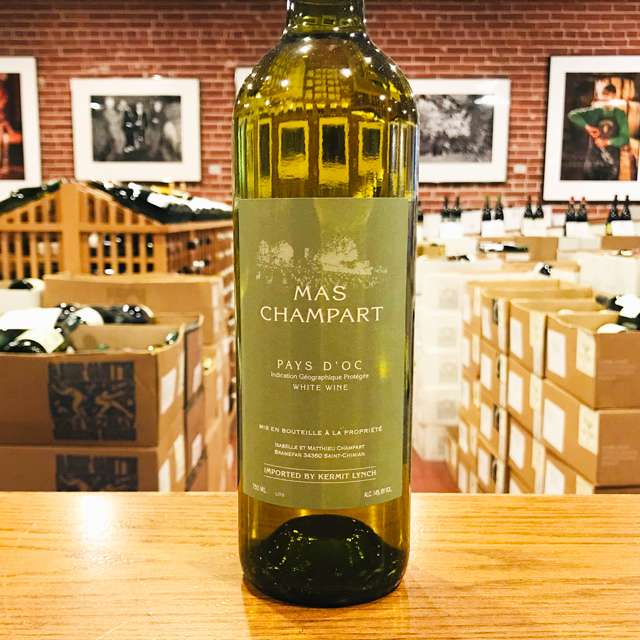Notify me
2018 Pays d’Oc Blanc
Mas Champart
At my home near Bandol, I’m planting the hillside in white grapes. My son and I decided on a blend: 40% Vermentino, 40% Marsanne, and 20% Terret Blanc. Here, have a taste of Terret vinified at Mas Champart. They have an old pre-clonal vineyard of it, and they vinify their white like I’ll want Domaine Tempier to vinify ours. Champart will supply the vine cuttings.
—Kermit Lynch
| Wine Type: | white |
| Vintage: | 2018 |
| Bottle Size: | 750mL |
| Blend: | 70% Terret, 30% Grenache Gris |
| Country: | France |
| Region: | Languedoc-Roussillon |
| Producer: | Mas Champart |
| Vineyard: | 1 ha, Terret planted in 1900, Grenache Gris 70 years old |
| Soil: | Limestone |
| Farming: | Lutte Raisonnée |
| Alcohol: | 13.5% |
More from this Producer or Region

2020 Saint-Chinian Rouge “Clos de la Simonette”
France | Languedoc-Roussillon
A Mourvèdre-majority masterpiece, lots of pleasure and even more soul.

Banyuls “Reserva”
France | Languedoc-Roussillon
You will be surprised how well this dessert wine will pair with toasted almonds, bleu cheese or nice dark chocolate.

2020 Collioure Rouge “La Pinède”
France | Languedoc-Roussillon
If you can’t make it to the south of France this year, here’s a way to bring the Mediterranean sun to you.

2022 Pic Saint Loup “Tour de Pierres”
France | Languedoc-Roussillon
A remarkably graceful rouge from one of our favorite appellations in southern France.

2021 Pic Saint Loup Rouge “Sainte Agnès”
France | Languedoc-Roussillon
Shows a kinship with the northern Rhône, echoing aromas of black olive and violets.

2021 Saint-Chinian Blanc
France | Languedoc-Roussillon
Showcasing impressive texture and flavors of citrus, stone fruit, and spring flowers, this offers a great pairing for grilled fish or seared scallops.

Banyuls Vinegar
France | Languedoc-Roussillon
This vinegar is particular because it’s made with sweet wine, which confers a very unique taste.

2021 Languedoc Rouge “Lou Maset”
France | Languedoc-Roussillon
There is a strangely beautiful harmony between earth, sun, and man.

2021 Corbières Rouge
France | Languedoc-Roussillon
The accents of herbal garrigue and vineyard stones offer just enough earthy terroir to counterbalance the chewy black fruit and mouth-coating wild brambleberry, making this bargain red the right bottle to uncork at any which moment.

2021 Monts de la Grage Blanc
France | Languedoc-Roussillon
These ancient hillside vines yield very little, giving an intensely concentrated juice with great acidity and a textured finish. Open it alongside seafood or as an apéritif.
 /
/
About The Producer
Mas Champart
About The Region
Languedoc-Roussillon

Ask wine drinkers around the world, and the word “Languedoc” is sure to elicit mixed reactions. On the one hand, the region is still strongly tied to its past as a producer of cheap, insipid bulk wine in the eyes of many consumers. On the other hand, it is the source of countless great values providing affordable everyday pleasure, with an increasing number of higher-end wines capable of rivaling the best from other parts of France.
While there’s no denying the Languedoc’s checkered history, the last two decades have seen a noticeable shift to fine wine, with an emphasis on terroir. Ambitious growers have sought out vineyard sites with poor, well draining soils in hilly zones, curbed back on irrigation and the use of synthetic fertilizers and pesticides, and looked to balance traditional production methods with technological advancements to craft wines with elegance, balance, and a clear sense of place. Today, the overall quality and variety of wines being made in the Languedoc is as high as ever.
Shaped like a crescent hugging the Mediterranean coast, the region boasts an enormous variety of soil types and microclimates depending on elevation, exposition, and relative distance from the coastline and the cooler foothills farther inland. While the warm Mediterranean climate is conducive to the production of reds, there are world-class whites and rosés to be found as well, along with stunning dessert wines revered by connoisseurs for centuries.
More from Languedoc-Roussillon or France
2021 Pic Saint Loup Rouge “Sainte Agnès”
Héritage du Pic Saint Loup France | Languedoc-Roussillon
2022 Vin de France Blanc “L'Estrade”
Maxime Magnon France | Languedoc-Roussillon
Vin de Pays Memoire “d’Automnes”
Domaine La Tour Vieille France | Languedoc-Roussillon
2021 Banyuls “Rimage”
Domaine de la Tour Vieille France | Languedoc-Roussillon
2021 Terrasses du Larzac Rouge
Les Vignes Oubliées France | Languedoc-Roussillon
2020 Gard Rouge “Clausus”
Ludovic Engelvin France | Languedoc-Roussillon
2022 Collioure Rouge “Puig Ambeille”
Domaine de la Tour Vieille France | Languedoc-Roussillon
2021 Languedoc Blanc “Les Cocalières”
Domaine d’Aupilhac France | Languedoc-Roussillon
2021 Corbières Blanc
“La Bégou”
Maxime Magnon France | Languedoc-Roussillon
2022 Vin de France Rouge “Saint Jacques”
Maxime Magnon France | Languedoc-Roussillon
2022 Pic Saint Loup Rosé
Héritage du Pic Saint Loup France | Languedoc-Roussillon
2019 Faugères
Domaine Leon Barral France | Languedoc-Roussillon
2021 Pic Saint Loup Rouge “Sainte Agnès”
Héritage du Pic Saint Loup France | Languedoc-Roussillon
2022 Vin de France Blanc “L'Estrade”
Maxime Magnon France | Languedoc-Roussillon
Vin de Pays Memoire “d’Automnes”
Domaine La Tour Vieille France | Languedoc-Roussillon
2021 Banyuls “Rimage”
Domaine de la Tour Vieille France | Languedoc-Roussillon
2021 Terrasses du Larzac Rouge
Les Vignes Oubliées France | Languedoc-Roussillon
2020 Gard Rouge “Clausus”
Ludovic Engelvin France | Languedoc-Roussillon
2022 Collioure Rouge “Puig Ambeille”
Domaine de la Tour Vieille France | Languedoc-Roussillon
2021 Languedoc Blanc “Les Cocalières”
Domaine d’Aupilhac France | Languedoc-Roussillon
2021 Corbières Blanc
“La Bégou”
Maxime Magnon France | Languedoc-Roussillon
2022 Vin de France Rouge “Saint Jacques”
Maxime Magnon France | Languedoc-Roussillon
2022 Pic Saint Loup Rosé
Héritage du Pic Saint Loup France | Languedoc-Roussillon
2019 Faugères
Domaine Leon Barral France | Languedoc-Roussillon
Kermit once said...

Kermit once said...
Great winemakers, great terroirs, there is never any hurry. And I no longer buy into this idea of “peak” maturity. Great winemakers, great terroirs, their wines offer different pleasures at different ages.
Inspiring Thirst, page 312














